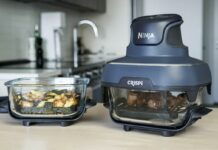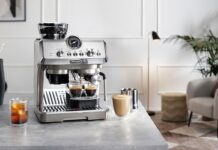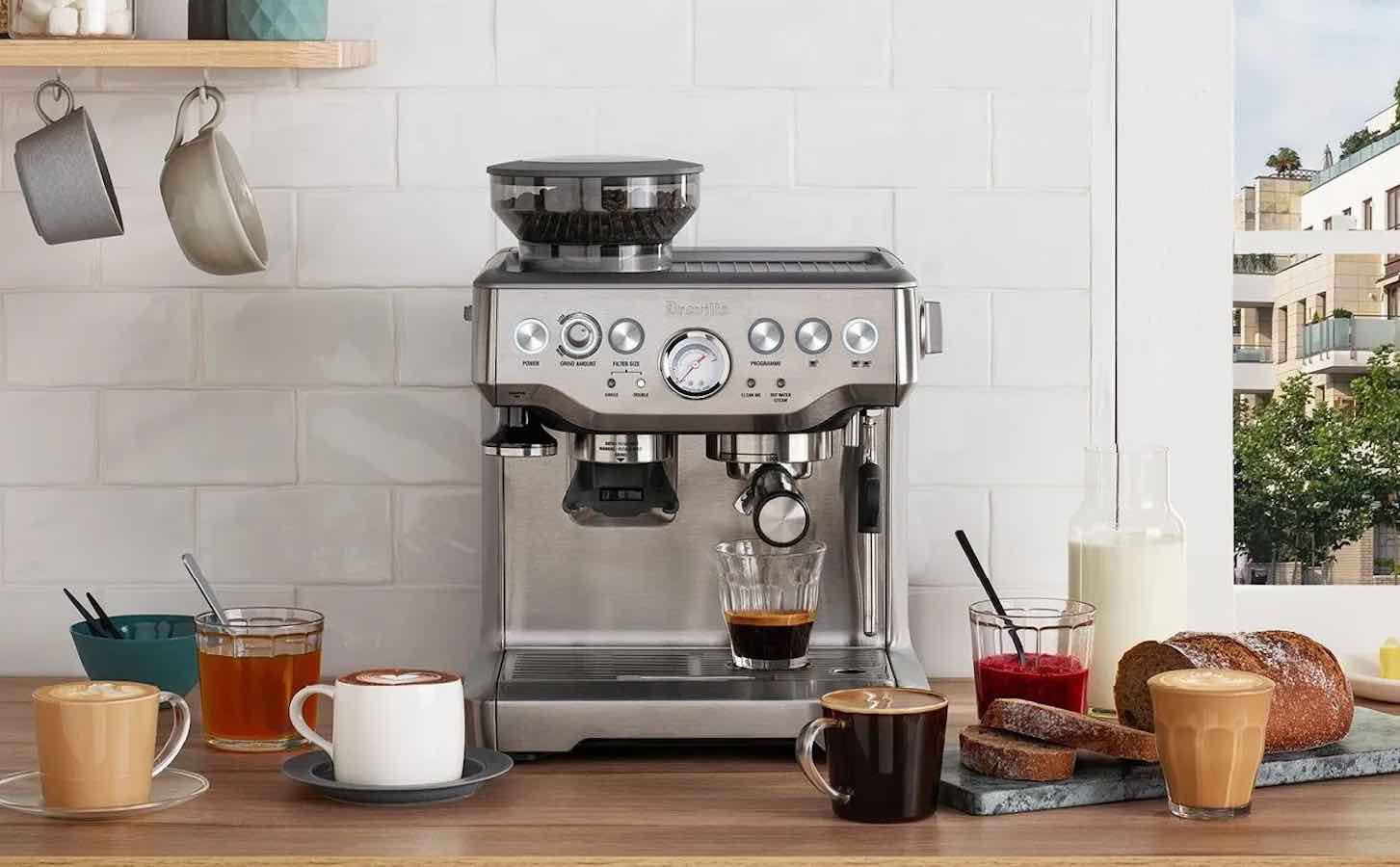
Making an espresso at home means you can be your own barista, brewing up delicious Cappuccinos, Americanos, and creating your own lattes with extra foam. The key to all of these hot beverages is the perfect espresso shot, and that’s easy to create when you have an espresso machine.
Table of Contents:
- Types of espresso machines
- What to consider before buying an espresso machine
- Maintaining and cleaning an espresso machine
- What can you make with an espresso maker?
Types of espresso machines

There are quite a few different types of espresso machines available, and you can narrow down your choices by asking yourself a few questions. The first and most important question is, how easy should your espresso maker be to use?
If you’d like to learn about every facet of creating coffee, you may want to choose a manual machine. Or, if you’d like a fully automated process, there are super automatic espresso types that offer you one-touch espresso creation and can clean up for you too. There are also a few options that let you get the best of both worlds.
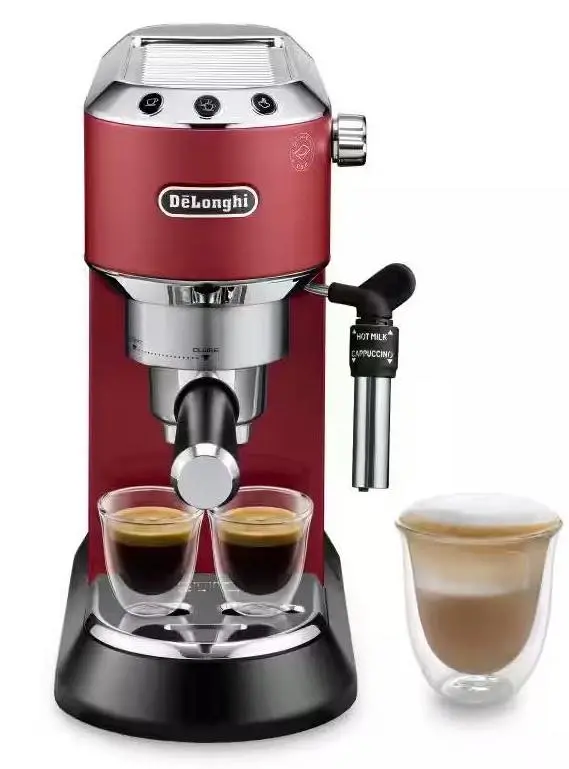
Manual Espresso Machine
If you want to control everything from the grind of your coffee bean to exactly how long your water will pour over your coffee grinds, you may want to choose a manual espresso machine.
These machines have a lever you pull down when you’re ready to create an espresso shot, and although they’re the best for coffee customization, creativity, and extra-long lifespan, they’re also difficult to master. Manual espresso makers are usually favoured by professional baristas or someone who’s mastered an automatic type of espresso machine.
Semi-automatic espresso machine
If you want to add a little electricity to your coffee creations, you’ll want to take a look at semi-automatic espresso machines. Semi-automatic espresso makers have electric pumps so they’re easier to use than a manual espresso machine, but they still give you a certain level of control over the creation of your espresso shot.
Although much easier to use than manual, semi-automatic espresso makers have a learning curve too. You control the water flow, tamping, and pressure, so if you’d like an even easier way to create espresso, consider a fully automatic espresso maker.
Fully automatic espresso machine
When the goal is to create custom beverages with little to no learning curve, you’ll love a fully automatic espresso maker. This type of espresso maker completely automates how much water is pushed over your coffee. Because of that, they’re very easy to use.
The only downside to a fully automatic espresso maker is you may lose control over the coffee-making process. Because water pressure and flow are so important to creating the perfect espresso shot, you have to rely on your machine to get it right every time.
Super Automatic Espresso Machine

Want to make the freshest coffee possible without all the fuss over settings or water temperature? A super automatic espresso machine is a one-touch wonder that lets you add your coffee grinds, touch a button, and gives you the perfect shot every time. Even better? These types of espresso makers are designed with features like built-in burr grinders, quick programmable settings, and they can grind, tamp, and brew all in one fluid motion.
Super automatic espresso makers are great for someone who drinks a lot of espresso during the day, and they want to ensure the shot is perfect without the extra effort.
What to consider before buying an espresso machine
With an espresso maker, you can completely customize your coffee. If you like stronger lattes, you can quickly brew two espresso shots instead of just one. Because you can find a range of machines from manual to completely automatic, you can tweak your coffee or let your machine do all the work. If you choose a model with frothing capability, you’ll also be able to create hot milk beverages too. Here are the top things to consider before buying an espresso maker.
1. Budget
Before you begin shopping for an espresso maker, you’ll want to consider how much you’d like to spend. There are a lot of different types, and they have different price points, and you’ll want to find the best balance between your budget and the features you’d like on your new machine. For example, manual espresso makers are generally less expensive than super automatic espresso makers, but with a manual machine you’ll need to learn how to grind your beans, tamp, and extract the right amount of water. An automatic machine will cost more as the machine will do everything for you, from grinding the beans, dosing and tamping your espresso shot, and pouring the shot.
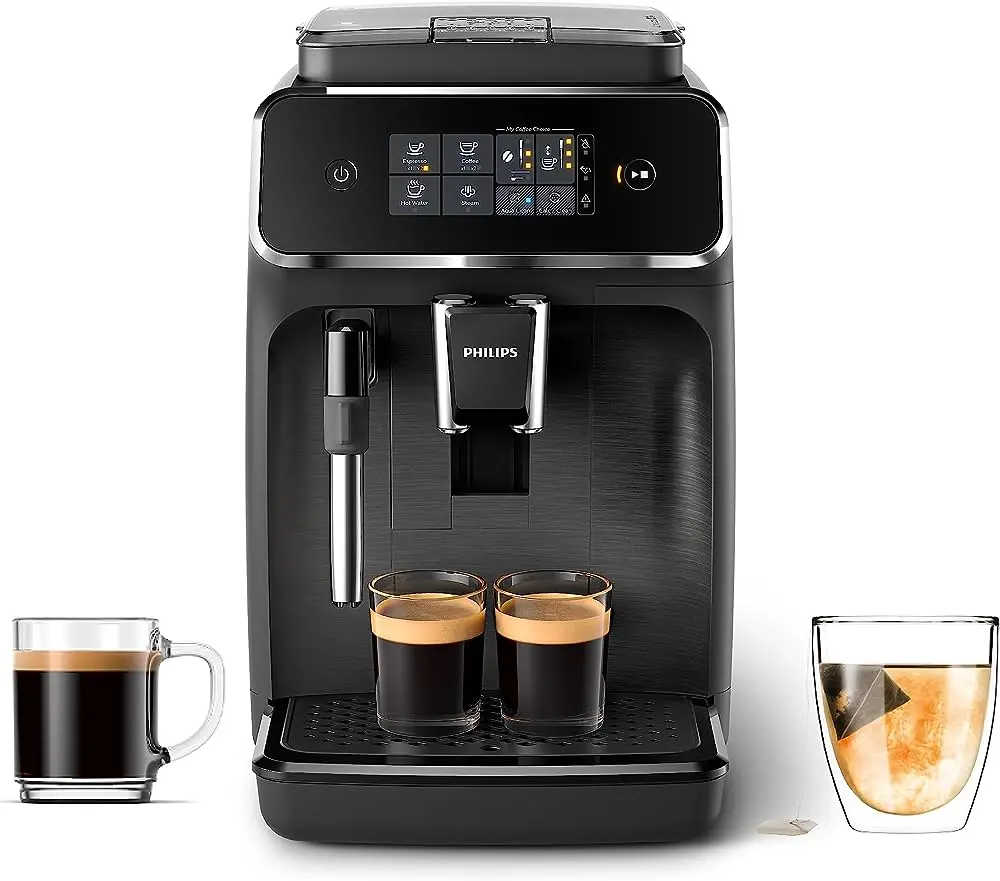
2. Size and space
Before choosing your espresso maker you’ll want to consider how much space you have on your countertop. Some espresso makers are quite a bit larger than others, so if you have limited space in your kitchen, you’ll want to choose a smaller, more compact machine or a hybrid machine that can make drip coffee as well as espresso.
3. Ease of use
An important consideration when choosing an espresso machine is how easy it is to use and where you’ll use it. If you’re choosing a new machine for your home and you don’t mind a bit of a learning curve, you’ll want to choose an espresso maker that’s user friendly, but also lets you customize your dose, tamp your own shots, or grind your own beans. If you’re choosing an espresso machine for the office, you may want a much easier-to-use machine, with pre-programmed drinks you can make with a touch of a button or an all-in-one machine that grinds, doses, tamps, and dumps your used espresso grinds into a bucket that’s easy to clean out.
4. Durability and build quality
The build quality of your espresso machine will depend on your budget and the type of machine you choose. Some espresso makers are made from stainless steel or aluminum while others have mainly plastic parts. You’ll find a lot of automatic and super automatic espresso machines are made from stainless steel. Stainless steel will resist rust and stand up to years of use. Less expensive espresso machines are generally made of plastic parts. They are durable as well, but they don’t tend to last as long as machines made from metal.
5. Precise temperature
Espresso machines can make the perfect shot of espresso every time because they’re equipped with technology that lets them heat up the water to at least 205°, with the ideal water temperature for brewing an espresso shot is anywhere from 195° to 205°. Once the water is hot, espresso machines use bars of pressure to push that water through a puck of freshly ground coffee beans. They process the coffee in approximately 30 seconds or less, and that’s so you can get the most robust taste for your beans.
To brew great espresso, you should look for an espresso machine with at least 9 bars of pressure, but you’ll find espresso machines that offer up to 17 bar pressure pumps.
6. Coffee bean grinder
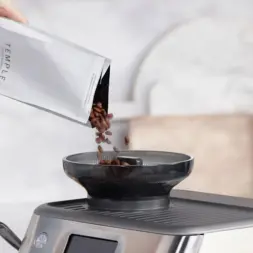
Also known as a conical burr grinder, a coffee bean grinder is built into some espresso machines. You can grind your beans right in the machine for the freshest brew, and because it’s built into the machine you save on counter space because you don’t need to buy an additional coffee bean grinder. To customize your espresso drink even more, you’ll want to choose an espresso machine with different grind levels. You’ll find espresso machine with different grind settings that range from 1 for a coarse grind up to 60 or higher for the finest grind.
The best shot of espresso starts with fresh espresso beans, so you’ll always want to grind the freshest coffee beans possible. You can look for espresso specific beans in bulk and only open the bag when you’re ready to grind your beans. When you’re finished pouring out your beans, you’ll want to seal the bag tightly shut until you use it again.
7. Water filtration
If you use tap water to create your espresso or you know your water has a lingering taste to it, you may want to purchase an espresso machine with a water filter built in. These water filters are usually disposable, so you use the filter for a few months and replace it when needed. Some types of espresso machine will remind you when it’s time to switch out your filter.
8. Programmability
There are a variety of automatic and super automatic espresso machines with touchscreens or dials that let you program your espresso shot or your beverage. You can tap the screen to select the drink you’d like, and the machine will take care of grinding the beans, dosing and tamping, and pouring your shot. Some programmable machines also have automatic milk frothers so they can froth your milk and pour it into your cup to make a latte or flat white.
9. Water source
Even if you have a machine with a water filter, for the best tasting espresso you’ll want to use filtered water. Tap water or unfiltered water can add an odd flavour or strong odour to your espresso shot. If you use hard water that contains a lot of minerals, you’ll find your espresso machine will quickly develop scale or build up over time. When using hard water, to prevent permanent damage you’ll need to clean your machine more often.
10. Boiler type
Depending on the espresso machine you choose, water is heated by one of three types of heating systems – a single boiler, thermoblock, or thermocoil. The heating system is responsible for the searing temperatures your espresso machine will reach to achieve the perfect shot, frothed milk, steam, or hot water.
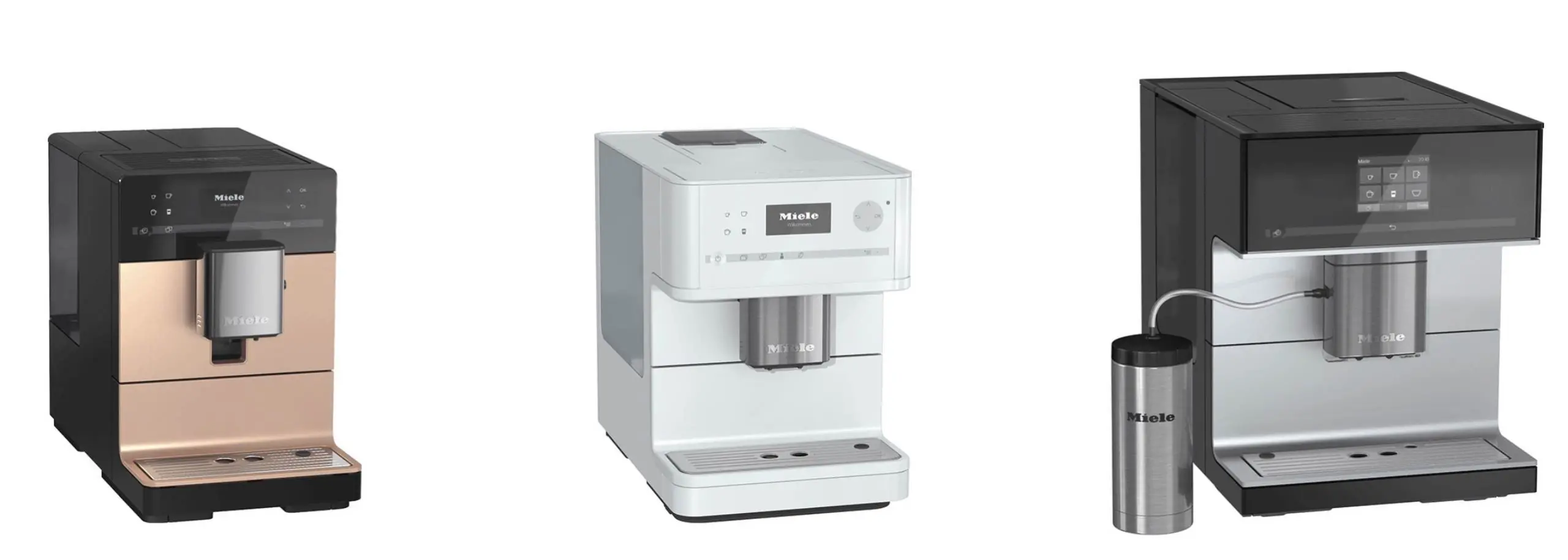
A single boiler espresso machine heats the water using a single heating element. This type of machine is a bit slower as it takes longer to heat up the water or make steam. A thermoblock system has a coiled heating element so it heats the water faster, and that lets you make temperature adjustments or quickly make several shots of espresso. A Thermocoil system uses a coiled heat exchange so it can maintain consistent temperatures and provide steam, all without wait time. If you don’t like to wait for your espresso, a thermocoil machine is the best option. If you don’t mind a bit of downtime but you want your machine to be able to heat up fairly quickly, a thermoblock machine is a good choice. Single boiler machines are an option if you don’t mind a bit of a wait time for heating and you aren’t worried about precise water temperatures.
11. Steam wand
Some espresso machines have a steam wand or milk steamer. This wand is built into the machine, and it boils and adds air to your milk to create tiny foam bubbles called milk foam or froth. Espresso machines with a milk steamer are popular because you can use your machine to create your espresso shot and steam your milk at the same time.
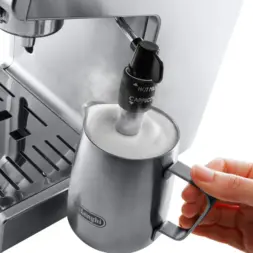
12. Frothers
Milk frothers are a device that adds air to milk using a metal whisk. Also called jug frothers, a milk frother isn’t normally built into an espresso machine but is something you can buy as an accessory if you like frothed milk. Some types of milk frothers use a jug and a lid to froth your milk and there are also handheld milk frothers that look like a small wand. They let you froth milk in your own mug.
The difference between a milk frother and a milk steamer is that a milk frother usually doesn’t heat up your milk. It froths the milk at whatever temperature it is. The milk steamers you find on espresso machines will add both heat and air to your milk, so your milk will be hot and ready to make a latte.
13. Espresso machine popular brands
There are many different types of espresso machines including Breville, Delonghi, Philips, Jura, Miele, and KitchenAid. These brands offer varying types of pump espresso machines including manual, semi-automatic, fully automatic, and super automatic. Depending on what brand you choose, you’ll find unique features including built-in grinders, 19 bar pumps, or cup warmers.
14. Smart home compatibility
Some types of espresso machines are equipped with Wi-Fi and can connect to your home’s network. Once connected you can use a companion app to turn the machine off and on, schedule it to turn on, or instruct it to make your espresso drink. Some types of espresso machines are also voice assistant compatible so you can ask your Google or Alexa to ‘Turn on your espresso machine’ when you’re ready to make a hot, delicious espresso.
Maintaining and cleaning an espresso machine
There are basic cleaning tasks you’ll take on each time you make espresso. You’ll want to wipe down the wand if you’ve used it to froth milk, and you’ll need to clean out the puck or pod that holds your grinds every time you use it. Some automatic machines will move your used coffee grinds to a container that you can remove from the machine to dump out your grinds.
There are also other types of cleaning including descaling and decalcifying. If you don’t want to worry about that type of ‘deep’ cleaning, you may want to choose an espresso machine with automatic descaling. You can purchase a variety of descaling and decalcifying solutions to keep your espresso machine in tip top shape.
What can you make with an espresso maker?
Once you begin making espresso at home, you’ll soon realize why creating coffee is a passion for so many people. There are so many delicious drinks you can make with espresso.
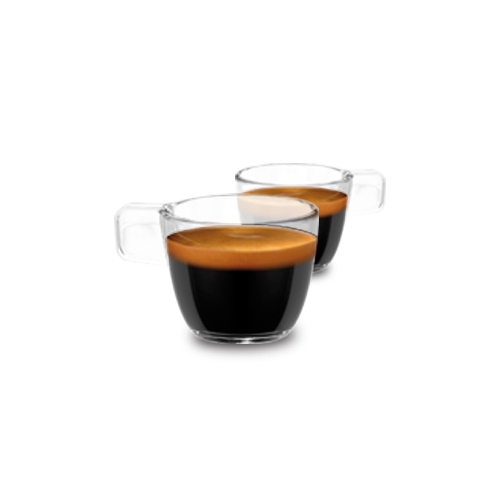 Espresso shot
Espresso shot
An espresso shot can be a drink itself. If you’d like to taste what fresh brewed coffee beans are like and wake up in an instant, try a single or double espresso shot.
Macchiato
A macchiato is an espresso shot with a small amount of steamed milk layered on top. It’s quite strong, so you may also add a layer of foam.
Cappuccino
A cappuccino is a popular drink created with a double shot of espresso, a layer of steamed milk, and a thick layer of foamed milk.
Mocha
A mocha is made in the same was as a cappuccino, but you add chocolate during the creation process.
Latte
A favourite for many people, lattes are created with two espresso shots, a thick layer of steamed milk, and a thin layer of foam. You can flavour your latte with coffee syrup and make any type of drink including vanilla, hazelnut, pumpkin spice, and maple lattes.
Espresso machine accessories
If your goal is to set up a coffee bar with your espresso machine as the centerpiece, you’ll want to add a few espresso machine accessories. Whether you drink a single espresso shot or you’d like to make lattes every day, having cups and mugs designed specifically for espresso can enhance your morning. A cup warmer keeps your espresso cup hot until you’re ready to drink it. If your espresso machine doesn’t come with a cup warmer, you may want to invest in one.
Take the next step
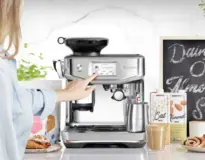
You’ll be a custom coffee expert when you bring home a new espresso machine. Take a look at all of the different styles and brands of espresso machines right now on Best Buy.







